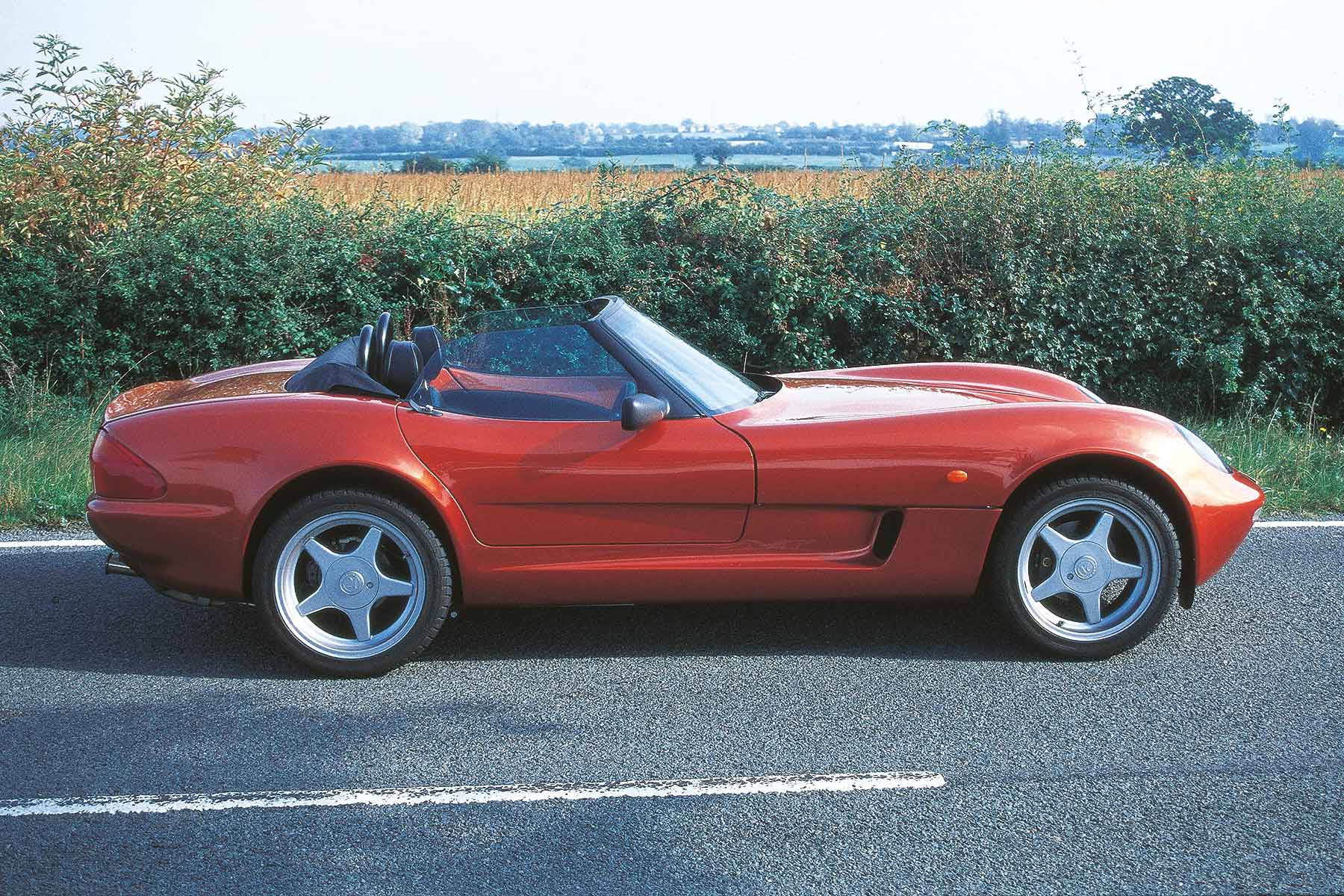You are simply buzzing. Your left leg is hot, your right arm is damp and a hot exhaust has singed your calf as you wriggle free of a low-roofed cockpit, the door almost slapping you in the face.
You’ve just driven 150 miles in the rain in a Caterham Seven – and loved every second. But your body is relieved to be escaping the close grip of the cabin, your ears are humming from the din and part of you wishes the experience had been just a little more comfortable.
Wouldn’t it be great, you find yourself thinking, if you could have all the thrills of a Seven in a car with a sensibly scaled cockpit that didn’t roar like a North Sea gale?
That very idea was exactly the one that Caterham Cars had in the early 1990s.
Caterham’s modern Seven

The plan was to rebody the Seven. Or more accurately, perhaps, to provide it with a body beyond the vintage wings, simple clam of a bonnet, that famous nose-cone and a big tray for a pair of seats and spare wheel mounting.
Instead, the Seven’s tubular chassis would get enveloping bodywork that looked more sports car-sensuous, and pushed through the air with less blustery commotion.
Why 21? Not because Caterham reckoned it was three times the car that the Seven was, but because it had been making the Seven for 21 years, this car a celebration of the fact.
It must have been quite a challenge to extract a flowing shape from the Seven’s proportions, the closeness of the occupants’ backsides to the back axle threatened to force the old-school proportions of a 1950s British roadster onto the new Caterham.
And that’s what it got, although your eye was drawn away by the shapely tail and its Ford Mondeo lamp clusters, plus the long bonnet and pair of air extractors whose exit ramps occupied much of the 21’s lower body.
The result was a car that looked a bit Brit sports car traditional and unusually narrow, despite adding three inches to the Seven’s front track to provide slightly wider footwells. However, it was neat and not unattractive.
The 21 looked more appealing inside, where a stylish twin binnacle fascia replaced the Seven’s simple flat panel. The centre of the dash cascaded into a narrow centre console and carried a strikingly stacked trio of dials, while the outer edges of the dashboard were body-coloured, as was much of the surface of the inner doors, making this cabin look a whole lot more contemporary. It was also very well finished.
The absence of window winders seemed contemporary too, the 21 having electric window lifts, you’d be thinking. Except that it didn’t, their opening was a task for the driver, who needed to demount the glass and stow it in the boot.
Still, it was an arrangement that made the 21 lighter, its 665kg kerb weight generating an exciting 205bhp per tonne when the car was fitted with the 136bhp 1.8-litre version of Rover’s all-alloy K Series engine. It was 110kg more than a Seven, but still 60kg less than a Lotus Elise.
Fear the Lotus Elise

Ah, the Elise. There was brief honeymoon for the 21 when the Lotus wasn’t present. The Caterham was unveiled in autumn 1994 with an alloy body, and appeared a year later at the 1995 Earls Court show with its glassfibre production shell.
Not many months afterwards, though, the Elise went on sale, and with the mid-engined layout that Caterham had originally considered – before concluding that this was too much of a leap for a tiny firm to take on.
The Lotus was also joined by the MGF, a milder-mannered sportster, but an able one nonetheless. Thus, the appearance of these two, alongside the Mazda MX-5, provided the 21 with formidable opposition. Those after a more extreme experience also had the Renault Sport Spider to choose from.
Still, the Caterham delivered formidable performance, its low weight allowing the 1.8 Supersport to burst to 60mph in 5.8 seconds and onto 131mph: far more than most Sevens could manage.
The more powerful 1.8 – there was a 1.6-litre version, too – also got you Caterham’s excellent six-speed gearbox. All of which added up to a riot of a drive, if not quite as much rebellion as you’d enjoy aboard a Seven. The 21’s steering lost a little of the Seven’s blade-sharp edge, and it felt heavier.
‘Simmering vegetable’

That would have mattered less if the 21 had delivered the extra civility implied by its bodywork. True, the ride was a little smoother, but you were still packed Ryanair-tight into the Caterham’s cockpit, its mechanicals made as much noise as an all-night party and if you left the roof on and the windows up, you’d boil like a simmering vegetable.
You needed the agility of a squirrel to get beneath the hood and bridge a bicycle lane’s width of sill before tumbling into your seat. In other words, several of the supposed advantages of a redesigned body failed to materialise.
And the 21 was inevitably more expensive, taking it straight into enemy territory. While the ultra-modern Elise 1.8 cost £19,950, the 1.6 litre Caterham 21 was £21,995 – or an ambitious £25,495 as a 1.8 Supersport.
An MGF 1.8i, meanwhile, was £17,440 and a base 1.6 Caterham Seven £17,850. It doesn’t take a marketing analyst to deduce that the 21 was going to sit somewhere between a hard and desperate place, as proven by an eventual sales tally of 48 cars between its announcement in 1994 and the end of production in 2000.
The 21 was a good effort for such a small company, but not quite good enough, and unlucky to face a barrage of fresh sports car competition. Ironically, the best of this came from Lotus, the original source of its bread-and-butter Seven.
These days the Caterhams 21 is almost entirely forgotten, but it makes a more convincing classic buy than it ever did as a new car. Provided you can actually find one for sale, that is.
READ MORE:
Caterham Super Seven 1600 review


